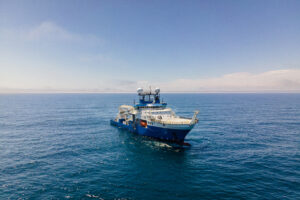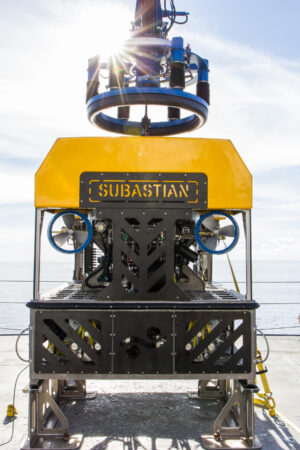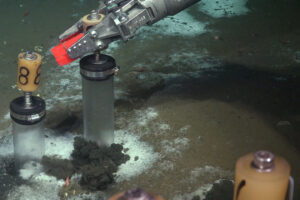By Grace Sferrazza (CAS & COM’26)
On the second leg of their 55 day research expedition to the Chilean Margin, Erin Frates’ exploration team had come face to face with an unavoidable obstacle: the weather.

An incoming storm had prevented the crew of scientists from checking out the area they planned to visit using a Remotely Operated Vehicle (ROV) named SuBastian. So the team shifted to plan B: using the ROV to explore a nearby submarine canyon—an underwater spot that connects the land surface area with the deep ocean.
The graduate students were serving as scientists aboard the Falkor, an exploratory research cruise off of the coast of Chile. Their goal was to explore never-before-seen areas of the Chilean coast for signs of methane seepage, novel biodiversity, and unusual hydrothermal vents; and be the first to do so using an ROV in this area.
Methane seeps, or cold seeps, are spots on the seafloor where methane is leaking out and fueling a community of microorganisms. Submarine canyons are underwater spots that connect land surface area with the deep ocean which contain environmentally sensitive areas.

“This is really an exploratory cruise to just see what’s there,” said Professor Jeffrey Marlow, assistant professor of biology at Boston University, who advised the students and served as a virtual co-chief scientist of the expedition. “And ultimately figure out which forms of life are there, how much they might matter for global methane fluxes and biogeochemistry.”
Marlow proposed the mission to the Schmidt Ocean Institute (SOI), a nonprofit organization that is dedicated to advancing the study of oceanography, and recruited geologists, biologists, and graduate students—building a diverse team of experts to fully take advantage of the underexplored region. The team included researchers from Chile, the United States, Portugal, Norway, Germany, the Netherlands, Spain, and Italy.
From September to December, the research crew surveyed nearly 20 methane seeps using the ROV SuBastian, as well as four submarine canyon systems that had previously never been seen by humans—finding an incredible abundance of animals living in surprisingly diverse ecosystems off the Chilean coast, including commercially valuable fish swimming in seep areas. The expedition traveled from Valparaiso to Punta Arenas, Chile, exploring the ocean from the central to the southern coastline of the country.

SuBastian’s sampling capabilities were crucial to the success of the mission. So when the opportunity arose for a dive to hunt for seeps during the storm, the students jumped on it. The night of the storm was, in fact, an opportunity. However, it was the middle of the night and the dive was unscheduled, so it took some convincing of the expedition’s chief scientists.
After pleading for a mini dive and promising a quick turnaround with the ROV, the chief scientists gave their blessing to the graduate students for the mission.
“[The ROV] was huge,” said Frates, a graduate student on the expedition and PhD student in the Ecology, Behavior, & Evolution program. “The major benefit is that, because of the cameras and the live data we get back from those cameras, we can be really particular about where we want our sediment cores collected.”

Sediment cores, they explained, “give you a snapshot of what the segment looks like in that area by depth”—illustrating the geology and microbiology of the seeps.
“Have you ever seen the Avengers? You know at the end when they’re eating shawarma together? There’d be multiple nights at like two in the morning where everyone would finally be done working, and we’d just be in the mess hall and just having all worked so hard, so many hours, so exhausted, and just enjoying each other’s company.”

While the data processing from the cruise is in its initial stages, early findings look promising, according to Frates. One result from the exploration showed greater biodiversity in microbial mats – groups of microbes on sediment – than the crew was expecting.
Marlow’s group is hoping to have finished data processing within a couple of years. For now, the team is combing through their immense pool of samples.
“We’re all just super excited to dive into the samples now,” said Marlow. “It’s been a long journey to get to this point, but this is where the fun part really starts.”